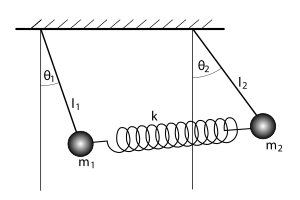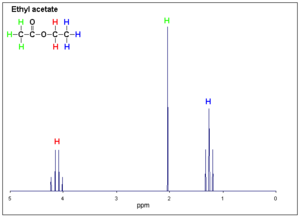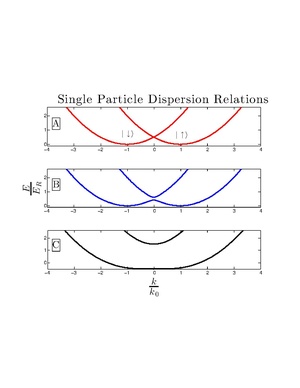ترابط (فيزياء)
| الترابط في العلوم |
|---|
| الترابط الكلاسيكي |
| ترابط كمومي |
في الفيزياء، two objects are said to be coupled when they are interacting with each other. In classical mechanics, coupling is a connection between two oscillating systems, such as pendulums connected by a spring. The connection affects the oscillatory pattern of both objects. In particle physics, two particles are coupled if they are connected by one of the four fundamental forces.
. . . . . . . . . . . . . . . . . . . . . . . . . . . . . . . . . . . . . . . . . . . . . . . . . . . . . . . . . . . . . . . . . . . . . . . . . . . . . . . . . . . . . . . . . . . . . . . . . . . . . . . . . . . . . . . . . . . . . . . . . . . . . . . . . . . . . . . . . . . . . . . . . . . . . . . . . . . . . . . . . . . . . . . .
ميكانيكا الموجات
Coupled harmonic oscillator
If two waves are able to transmit energy to each other, then these waves are said to be "coupled." This normally occurs when the waves share a common component. An example of this is two pendulums connected by a spring. If the pendulums are identical, then their equations of motion are given by
These equations represent the simple harmonic motion of the pendulum with an added coupling factor of the spring.[1] This behavior is also seen in certain molecules (such as CO2 and H2O), wherein two of the atoms will vibrate around a central one in a similar manner.[1]
دوائر LC المترابطة
In LC circuits, charge oscillates between the capacitor and the inductor and can therefore be modeled as a simple harmonic oscillator. When the magnetic flux from one inductor is able to affect the inductance of an inductor in an unconnected LC circuit, the circuits are said to be coupled.[1] The coefficient of coupling k defines how closely the two circuits are coupled and is given by the equation
where M is the mutual inductance of the circuits and Lp and Ls are the inductances of the primary and secondary circuits, respectively. If the flux lines of the primary inductor thread every line of the secondary one, then the coefficient of coupling is 1 and In practice, however, there is often leakage, so most systems are not perfectly coupled.[1]
الكيمياء
Spin-spin coupling
Spin-spin coupling occurs when the magnetic field of one atom affects the magnetic field of another nearby atom. This is very common in NMR imaging. If the atoms are not coupled, then there will be two individual peaks, known as a doublet, representing the individual atoms. If coupling is present, then there will be a triplet, one larger peak with two smaller ones to either side. This occurs due to the spins of the individual atoms oscillating in tandem.[2]
الفيزياء الفلكية
Objects in space which are coupled to each other are under the mutual influence of each other's gravity. For instance, the Earth is coupled to both the Sun and the Moon, as it is under the gravitational influence of both. Common in space are binary systems, two objects gravitationally coupled to each other. Examples of this are binary stars which circle each other. Multiple objects may also be coupled to each other simultaneously, such as with globular clusters and galaxy groups. When smaller particles, such as dust, which are coupled together over time accumulate into much larger objects, accretion is occurring. This is the major process by which stars and planets form.[3]
الپلازما
The coupling constant of a plasma is given by the ratio of its average Coulomb-interaction energy to its average kinetic energy—or how strongly the electric force of each atom holds the plasma together.[4] Plasmas can therefore be categorized into weakly- and strongly-coupled plasmas depending upon the value of this ratio. Many of the typical classical plasmas, such as the plasma in the solar corona, are weakly coupled, while the plasma in a white dwarf star is an example of a strongly coupled plasma.[4]
ميكانيكا الكم
Two coupled quantum systems can be modeled by a Hamiltonian of the form
ترابط العزم الزاوي
When angular momenta from two separate sources interact with each other, they are said to be coupled.[6] For example, two electrons orbiting around the same nucleus may have coupled angular momenta. Due to the conservation of angular momentum and the nature of the angular momentum operator, the total angular momentum is always the sum of the individual angular momenta of the electrons, or[6]
فيزياء الجسيمات و نظرية الحقل الكمومي
Particles which interact with each other are said to be coupled. This interaction is caused by one of the fundamental forces, whose strengths are usually given by a dimensionless coupling constant. In quantum electrodynamics, this value is known as the fine-structure constant α, approximately equal to 1/137. For quantum chromodynamics, the constant changes with respect to the distance between the particles. This phenomenon is known as asymptotic freedom. Forces which have a coupling constant greater than 1 are said to be "strongly coupled" while those with constants less than 1 are said to be "weakly coupled."[7]
. . . . . . . . . . . . . . . . . . . . . . . . . . . . . . . . . . . . . . . . . . . . . . . . . . . . . . . . . . . . . . . . . . . . . . . . . . . . . . . . . . . . . . . . . . . . . . . . . . . . . . . . . . . . . . . . . . . . . . . . . . . . . . . . . . . . . . . . . . . . . . . . . . . . . . . . . . . . . . . . . . . . . . . .
المراجع
- ^ أ ب ت ث Pain, H.J. (1993). The Physics of Vibrations and Waves (Fourth ed.). West Sussex, England: Wiley. ISBN 0-471-93742-8.
- ^ "5.5 Spin-Spin Coupling". Chemistry Libretexts. 2015-07-21. Retrieved 13 Apr 2017.
- ^ Kaufmann, William (1988). Universe, Second Edition. W.H. Freeman and Company. ISBN 978-0-7167-1927-4.
- ^ أ ب Ichimaru, Setsuo (1986). Plasma Physics. Menlo Park, California: Benjamin/Cumming Publishing Company. ISBN 978-0-8053-8754-4.
- ^ أ ب Hagelstein, Peter; Senturia, Stephen; Orlando, Terry (2004). Introductory Applied Quantum and Statistical Mechanics. Hoboken, New Jersey: Wiley. ISBN 978-0-471-20276-9.
- ^ أ ب ت Merzbacher, Eugene (1998). Quantum Mechanics (Third ed.). Wiley. ISBN 978-0-471--88702-7.
- ^ Griffiths, David (2010). Elementary Particle-Second, Revised Edition. Wiley-VCH. ISBN 978-3-527-40601-2.














